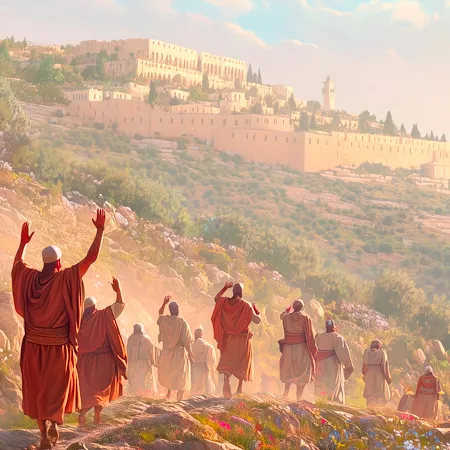In 2025, Sukkot begins on the evening of Monday, October 6, and ends on the evening of Monday, October 13. Three times a year, all of Israel was required to appear before the Lord in Jerusalem to observe the appointed feasts. No matter where they lived in the countryside, they left their homes and traveled to Jerusalem to stand before the Lord.
As they journeyed, they met others along the way, forming large traveling groups. These groups often broke into spontaneous song, with Psalms 120–134 becoming their repertoire. Known as the Psalms of Ascent, these songs uplifted and inspired them as they climbed hills, descended valleys, and ascended toward Jerusalem and Mount Zion.
Psalm 122 captures the excitement they felt in their hearts:
I rejoiced with those who said to me, “Let us go to the house of the LORD.” Our feet are standing in your gates, O Jerusalem. Jerusalem is built like a city that is closely compacted together. That is where the tribes go up, the tribes of the LORD, to praise the name of the LORD.
The Feast of Tabernacles was one of the most joyous festivals they celebrated. By this time, their crops had been stored and their fruits gathered. They awaited the softening and refreshment of the latter rain to prepare the land for a new crop. This feast of the seventh month was like a Sabbath to them. After completing their harvest labors, joy and thankfulness welled up in their hearts as they reflected on the abundance the Lord had provided.
Dwelling in booths symbolized the tents their forefathers lived in during their 40 years in the wilderness. The gathering crowds also foreshadowed the nations coming together to worship the Lord in Jerusalem during the final harvest.
As their journey continued, Jerusalem remained their focus. At first, they might catch a distant glimpse of the city, high upon the mount. As they approached, the city might briefly disappear behind a ridge of Mount Olivet. But as they rounded a turn, the entire city came into view.
Jerusalem, with its valleys, hills, walls, towers, palaces, and winding streets, seemed almost like a vision from another world. Yet surpassing all was the Temple Mount. Rising terrace upon terrace, its courts stood high above the city. The Temple itself, with its cedar roof and rich ornamentation, gleamed as a mass of snowy marble and gold, glittering in the sunlight against the green backdrop of Mount Olivet.
When the pilgrims arrived, the city already buzzed with a festive air. Colorful booths adorned rooftops, courtyards, roads, and gardens within a Sabbath’s day journey, giving the city a picturesque appearance.
Upon arrival, each pilgrim found a place to build their booth, constructed from branches of olive trees, myrtles, palms, and other shade trees. They lived in these booths for seven days.
© 2025 B Arnold Stein

Leave a Reply